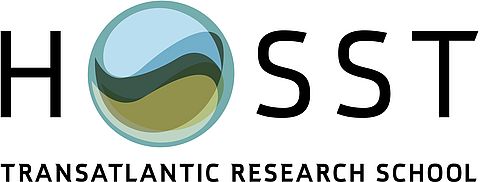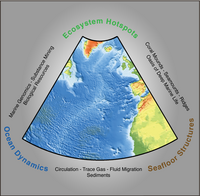The Research School is organized around three themes which encompass key sensitivities of the North Atlantic to external forcing and resource exploitation: 4D Ocean Dynamics, Ecosystem Hotspots, and Seafloor Structures. Interactions within and between these themes regulate how the ocean system responds to both anthropogenic and natural change. Only when we understand such interactions will we be able to predict, and eventually manage, the effects of ocean use.
Seafloor Struct ures
ures
The structure of t he seafloor is created by volcanic, tectonic and sedimentary processes operating over millions of years. Different structures serve as oases for marine biodiversity (by providing conditions such as hard substrate and by channeling ocean currents), are the source of both geohazards (volcanic and mass wasting) and mineral resources (manganese crusts, polymetallic sulphides), and directly influence ocean dynamics (circulation, mixing) and climate. Seamounts and ocean islands as volcanic structures thus play a major role as substrates enabling biodiversity evolution, but also for natural hazards like mass wasting and volcanism, for example at Iceland and the Canary, Azores and Cape Verde Islands).
he seafloor is created by volcanic, tectonic and sedimentary processes operating over millions of years. Different structures serve as oases for marine biodiversity (by providing conditions such as hard substrate and by channeling ocean currents), are the source of both geohazards (volcanic and mass wasting) and mineral resources (manganese crusts, polymetallic sulphides), and directly influence ocean dynamics (circulation, mixing) and climate. Seamounts and ocean islands as volcanic structures thus play a major role as substrates enabling biodiversity evolution, but also for natural hazards like mass wasting and volcanism, for example at Iceland and the Canary, Azores and Cape Verde Islands).
The role played by seafloor structures in questions of biodiversity, hazards and resources and also as a pre-requisite for understanding ocean circulation means they are central to many ocean management decisions. The HOSST fellows will gain an in-depth understanding of how seafloor structures are formed and evolve and how they interact with other ocean systems. Once more, this will provide a solid foundation for the formulation of scientifically-sound management practices.
4D Ocean Dynamics
The ocean is a three dimensional system evolving through time. It exchanges materials and energy with both the atmosphere and the seafloor. Understanding of the ocean’s physical state and biogeochemistry on all timescales depends on knowledge of the exchange of heat, freshwater, momentum and material across these two important interfaces. The interfacial fluxes are governed by physical, chemical and biological transport and transformation processes, most of which are closely coupled to the pelagic biosphere. Past and present climate change and chemical additions alters processes at the atmosphere-seawater transition affecting chemical and biological processes as well as ocean circulation dynamics. In particular, vertical processes, including convection and upwelling, exert a strong control on water temperature, salinity and density distributions, influencing ventilation of the deep ocean and biogeochemical processes throughout the water column.
From an ocean management perspective, the knowledge of the ocean circulation and the mass and energy exchanges across the ocean´s interfaces is essential both to be able to assess the possible effectiveness of climate change mitigation measures and to be able to provide dependable advice on the time-constants of such changes.
Ecosystem Hotspots
Life originated in the sea and the oceans harbor a tremendous diversity of life forms. Important biological hotspots in the Atlantic Ocean are associated with seafloor structures but also with the 4D dynamics of the ocean, making all these three aspects intimately related. Such hotspots on the seafloor include seamounts and cold water coral mounds and the hydrothermal vents along the spreading axes.
The importance of ecosystem response to human-induced change is a central feature of ocean management efforts. By providing the HOSST students with insights into the complex ecosystem interactions in the deep sea and how these depend on combinations of environmental factors, they will have the necessary background to advise and formulate science-based management recommendations.
A central objective is to study the basis of adaptation of diverse organisms to oceanic and deep sea environments and to ongoing climate and environmental change using state-of-the art genomic tools. This way, features of genomes can be identified that promote both vulnerability but also rapid adaptive change, for example in fish species, towards oxygen minimum zones and ocean warming. Knowledge on the genetic /genomic resources will also aid the utilization of bioactive substances in a sustainable way, and help cultivating marine organisms (aquaculture), including the identification of novel target species.
Ocean Technologies
The oceans are notoriously difficult to investigate due to their enormity, complexity, opacity, variability and inhospitability to humans. A consequence is that human exploration of the oceans, and our scientific understanding of how they function, is limited by available technologies.
Technology development has always been fundamental to ocean research, and application of new technologies and measurement approaches has frequently been the basis for major breakthroughs in understanding. In recognition of this historical and continuing central role, the school will ensure that its students have access to the most modern and powerful technologies available for addressing the School’s 3 major themes. Development and application of new technologies will be an important aspect of many of the PhD projects.
Sophisticated oceanographic modeling is now a necessary and central component of ocean studies in all disciplines, in part due to the inaccessibility and huge volume of the oceans themselves and the need to interpret and extrapolate temporally- and spatially-limited data to larger scales and into the past or future. Models coupling the oceanic and atmospheric circulation are at the cutting edge of climate change research and the development of biological and ecological modeling approaches that can account for adaptation and evolution is critical to an understanding of human impacts on marine ecosystems. PhD students will have the opportunity to further improve and test novel modeling approaches against new data gained within the School.
A unifying theme of the School will be the focusing of research along a „Transatlantic Transect“ comprising three key geographical research areas within the North Atlantic, all of which are subject to a growing range of human-induced pressures and present and future patterns of exploitation.




 ures
ures
